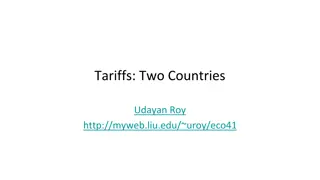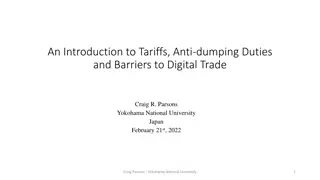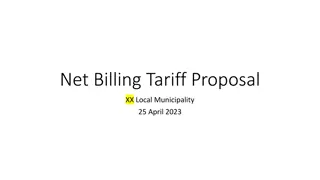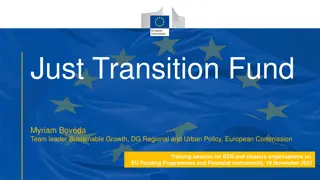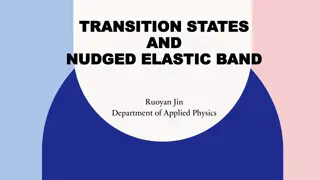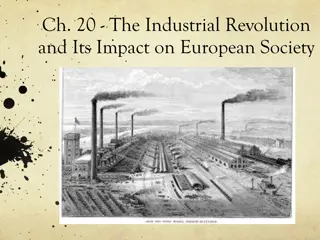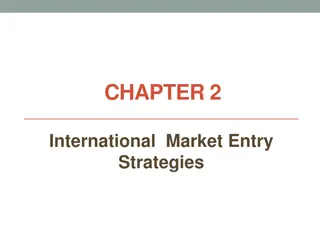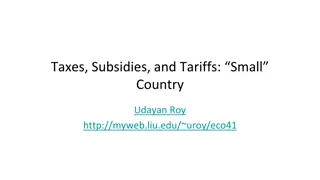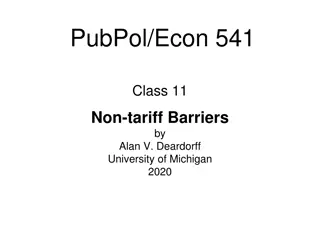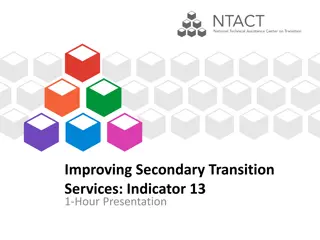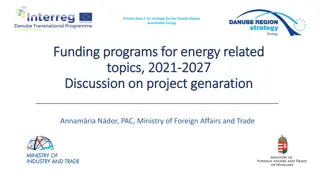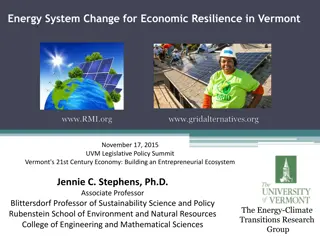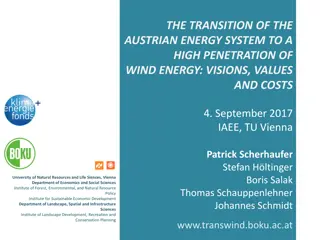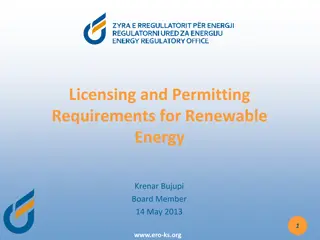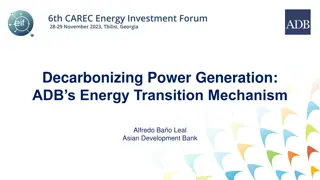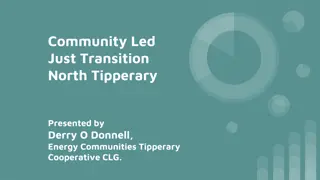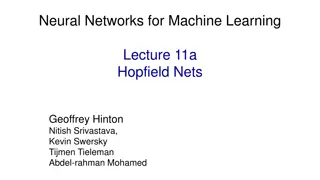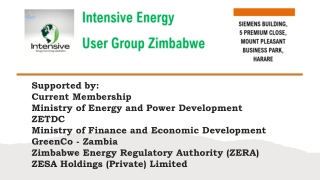Energy Transition & Network Tariffs: Challenges & Solutions
Exploring the energy transition in the electricity market, this research focuses on the fairness of dynamic network tariffs as a solution for network congestion. It delves into the complexities of balancing and congestion faced by grid operators, addressing issues related to incentives, wholesale market transactions, and grid capacity. The study also highlights the utilization of zonal markets and the allocation of transport capacity to manage congestion effectively.
Download Presentation

Please find below an Image/Link to download the presentation.
The content on the website is provided AS IS for your information and personal use only. It may not be sold, licensed, or shared on other websites without obtaining consent from the author. Download presentation by click this link. If you encounter any issues during the download, it is possible that the publisher has removed the file from their server.
E N D
Presentation Transcript
faculty of economics and business centre for energy economics research 1 | Energy transition, distribution grids and network tariffs Fairness of dynamic network tariffs as solution for network congestion Machiel Mulder Professor of Regulation of Energy Markets Faculty of Economics and Business University of Groningen PowerWeb Institutute, TU Delft 15 November 2019
faculty of economics and business centre for energy economics research 2 | Outline Energy transition and the electricity networks Network tariffs Fairness of dynamic network tariffs
faculty of economics and business centre for energy economics research Energy transition in the electricity market grid operator faces two challenges: balancing and congestions | 3 EU Electricity user Emissions Trading Scheme Factory Bilateral trade, Over- the-Counter, (OTC) Electricity producer Wind turbines Network (grid) Gas- fired power plant Coal- fired power plant Balancing market Electricity producer Solar panels Electricity user Green certificates market House Heat pump, E-car Retailer Power exchange
faculty of economics and business centre for energy economics research For balancing: grid operator gives incentives to help wholesale market transactions are linked to balancing | Real time (15 min) (balancing market) E-programme (net-in- or outflow) to be submitted to system operator (TSO) Day before real time Portfolio of contracts (in MWh) Day-ahead Actual inflow/outflow should match E-programme (otherwise: imbalance) Monthly ahead If new information: adaptation of commitments in intra-day market (between day- ahead market closure and real- time) Quarterly ahead Year-ahead contracts
faculty of economics and business centre for energy economics research | For grid capacity: hardly incentives to help to prevent congestion Copper plate for traders, no network constraints within zones ( zonal markets ) Europe is divided in zonal markets Within zone congestions are solved through redispatch Between zones limited transport capacity, which is allocated in different ways, including auctions
faculty of economics and business centre for energy economics research 6 | Allocation of capacity on Dutch-German border Short-term: implicit auction (market coupling) Long-term: explicit auctions Source: http://www.jao.eu/marketdata/yearlyauctions
faculty of economics and business centre for energy economics research 7 | Within market zone, no allocation of capacity network tariffs are not related to capacity / bottlenecks network tariffs are only meant to reimburse costs of network operator, including the costs to solve congestion (i.e. costs of redispatch) tariffs consist of fixed fee per year (independent of actual use) variable fee (related to size of annual transport use) (not for households anymore) hence level of tariffs may increase if network operators have to make many costs for solving congestion, but the tariffs are not related to occurrence/size of congestion
faculty of economics and business centre for energy economics research 8 | What is problem? impact of renewable energy on congestion In principle, network operators should prevent that market parties experience network constraints by making forecasts of future load and generation and invest in capacity timely Currently, renewable energy is strongly stimulated in regions where network capacity is not sufficient / cannot quickly expand What can they do? Give incentives to network users to adapt their behaviour to network situation investments: do not invest in region where network capacity is scarce operation: do not generate/consume at times when network capacity is scarce Hence, this would result in location-and-time differentiated tariffs
faculty of economics and business centre for energy economics research | Economically, dynamic tariffs are more efficient Principle of peak-load pricing - product must be non-storable - capacity must be in place for a period of time Supply curve (short-run MC) Ppeak Optimal incentives: network users: users in peak periods pay for variable plus fixed costs users in offpeak periods pay only for variable costs Peak demand Poffpeak Offpeak demand capacity Network operator: only invest if expected revenues from peak prices > investment costs
faculty of economics and business centre for energy economics research | How fair are dynamic grid tariffs? 3 perspectives Behavioural economics Ethics Economics This part is based on Neuteleers, S., Mulder, M., & Hindriks, F. (2017). Assessing fairness of dynamic grid tariffs. Energy Policy, 108, 111-120
faculty of economics and business centre for energy economics research | What can we learn from behavioral economics on fairness of peak prices? Example 1: Selling snow shovels (Frey & Pommerehne 1993) 'A hardware store has been selling snow shovels for $15. The morning after a large snow storm, the store raises the price to $20? Please rate this action as: completely fair/acceptable/unfair/very unfair' 83% unfair or very unfair 69% very unfair result has been confirmed in studies in several countries
faculty of economics and business centre for energy economics research | What can we learn from behavioral economics on fairness of peak prices? Example 2: Travelling by train in snow storm (Raux et al. 2009) Three TGVs are scheduled in the evening, but because of a snow storm only one travels between Paris and Lyon. What is a fair allocation? a) Available seats are given to people willing to pay an exceptional supplement of 30 Euros (peak pricing) Fair?: 10% b) Passengers are allowed to board the train until all seats are taken (queuing; first-comes, first-served) Fair?: 37% c) Priority is given to elderly persons, pregnant women and people with young children (moral rule) Fair?: 90%
faculty of economics and business centre for energy economics research | Lessons from behavioural economics Why is peak pricing seen as unfair? Not cost-based if one is (not) confronted with higher costs, the producer does (not) deserve a higher price Market exploitation excess demand, people s price elasticity and higher ability to pay are not seen as a good reason for deserving more profit excess demand, low price elasticity and low ability to pay (part of WTP) might be indicators of needs (dependency) Unpredictable unpredictable events allow for little alternatives (dependency)
faculty of economics and business centre for energy economics research 14 Perception of unfairness can be reduced by specific measures | REASON INTERPRETATION MEDIATION Peak pricing is perceived as The explanation that people see peak Possible ways of moderating unfair if it is pricing as unfair is that unfairness perception: not cost-based if one is not confronted with higher costs, relate price to costs the producer does not deserve a higher clarify relation with costs price based on market exploitation excess demand, people s price elasticity use revenues to address problems at (using market features just to and higher ability to pay (part of WTP) are stake (e.g. additional supply) increase profit) not seen as a good reason for deserving increase trust in agency (e.g. by more profit consultation and participation) consider compensatory measures excess demand, low price elasticity and guarantee minimal provision low ability to pay (part of WTP) might be indicators of needs (dependency) unpredictable unpredictable events allow for little apply to reoccurring situation rather alternatives (dependency) than to exceptional ones provide more information about when and how
faculty of economics and business centre for energy economics research | Lessons from ethics Which principles? General, widely supported, found in justice literature Ethical criteria: Equal: formal equal treatment Ability to pay meeting basic needs (affordability) no increase current inequality Costs cost causation Benefits related to net benefits
faculty of economics and business centre for energy economics research 16 Assessing alternative network tariff designs | Tariff design Definition Capacity charge The grid tariff is based on the size of the connection (capacity). In this case, the size of the connection determines how much power one can use on one moment and thus to which extent one can load the grid. Transport charge The grid tariff is based on the total consumption within one year, households using more electricity consequently pay a higher contribution for the use of the network. Flat rate Every household pays the same grid tariff, independently of income and consumption. Socialised flat rate The grid tariff is equal for all households but the costs are partly paid through general tax revenues. Everyone is thus contributing to the extent he/she is paying taxes. Ramsey prices Companies pay a lower grid tariff than households because companies are more sensitive for price changes on the electricity market. Peak pricing The grid tariff is higher during the moments the grid is intensely loaded, during non-peak moments one pays a lower grid tariff.
faculty of economics and business centre for energy economics research 17 Ethical assessment of network tariffs | Tariff-design options Transport & Ideal type of Distributive Flat rate Ramsey pricing Peak pricing principles for fair principle (possibly partly capacity charge distribution socialised) 1. Equality Formal equal + + + treatment (price elasticity is morally arbitrary criterion) 2. Ability to pay (a) Meeting basic / + / + needs (+ if socialised (requires study on (low-use probably (peak use probably through relation use levels low elasticity and less accessible to progressive taxes) / + and income levels) / + thus high prices) less well-off) / + (b) According to ability to pay (+ if socialised (requires study on (low-use probably (requires study on through relation use levels low elasticity and relation peak use progressive taxes) and income levels) + thus high prices) and income levels) + 3. Costs Cost causation (kWh & kW are (higher price if (no relation with proxies for cost for (no relation with network faces costs) network) + costs) ? congestion costs) + ( / +) 4. Benefits Equalise net benefits (everyone pays (those who (because of mix (those benefitting the same, use/benefit more, preference from peak use independent of contribute more) intensity and ability contribute more) benefits) to pay are benefits unclear)
faculty of economics and business centre for energy economics research 18 | Integrated assessment of network tariffs Tariff-design option Perspective Evaluative criterion Flat rate Transport & Ramsey pricing Peak pricing (socialised) capacity charge Allocative Economic / + + + efficiency Cost-based + / + Behavioural- Non-exploitation + + economic Predictability + + + Formal equal + + + treatment Meeting basic / + / + needs Ethical According to ability / + / + / + to pay Cost causation + + Equalise net + ? + ( / +) benefits
faculty of economics and business centre for energy economics research 19 | Results of survey among Dutch consumers on fairness perceptions of grid-tariff designs (N=1541) very fair fair neutral unfair very unfair no fairness score opinion 1. Capacity charge 9.7 43.8 24.4 14.4 2.8 4.9 36.4 2. Transport charge 17.7 53.4 12.2 10.8 3.9 2.0 56.3 3. Flat rate 10.9 25.2 18.5 30.3 12.8 2.3 -7.0 4. Socialised flat rate 4.9 31.1 24.7 25.5 9.9 4.0 0.6 5. Ramsey (proxy) 1.2 5.6 16.5 44.8 27.7 4.2 -65.6 6. Peak pricing 6.2 32.7 23.6 25.4 8.6 3.6 4.8 6bis. Framed peak pricing 7.0 42.7 18.3 23.2 7.9 1.0 18.5
faculty of economics and business centre for energy economics research 20 | Fairness score of different grid-tariff designs Fairness score = % (very) fair - % (very) unfair
faculty of economics and business centre for energy economics research 21 | Conclusion From ethical perspective, dynamic prices are not necessarily unfair Dynamic network tariffs are perceived as unfair if not based on a change in underlying costs based on excess demand, price elasticity or willingness-to-pay (market exploitation) if it is unpredictable Unfairness perception of peak pricing is reduced if: it concerns reoccurring, predictable situations revenues are used to address problems at stake by e.g. additional supply there is more trust in the pricing agency
faculty of economics and business centre for energy economics research | Contact details: Prof. Machiel Mulder Centre of Energy Economics Research (CEER) Faculty of Economics and Business University of Groningen Homepage: http://www.rug.nl/staff/machiel.mulder


